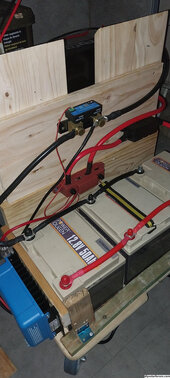first and foremost a happy christmas. i have 3 50ah powerqueen lifepo4 batteries in parallel.I want to buy another 50ah battery so that I have 200ah. Is it better to have 1 200ah battery or 4 50ah batteries in parallel?Should there be a fuse between the batteries connected in parallel?thank you and have a nice day,cheers...
You are using an out of date browser. It may not display this or other websites correctly.
You should upgrade or use an alternative browser.
You should upgrade or use an alternative browser.
stupid question
- Thread starter davy
- Start date
Steve_S
Offgrid Cabineer, N.E. Ontario, Canada
There are NO STUPID QUESTIONS EXCEPT FOR THE ONES NOT ASKED !
Below are A-Typical" installations. Each battery pack is Fused. You can use MRBF (up to 36V) , Class-T or Mega-Fuses. for 12V, MRBF is very suitable. Each should be fused for Max Output amps which is likely 50A for each battery pack. You can have as many packs in parallel as you like. Just remember that both Load & Charge are divided proprotionately between the packs in the Battery Bank.
Assuming a typical battery pack. 50AH should be able to output a max of 50A for 1 hour and take 25A Charge for 2 hours MAX. 4 Packs combined can take 100A for 2 hours. ALTHOUGH it is better to charge at a slightly lower Amperage, usually around 0.3C, which translates to about 15A per battery pack.
YES, You can also have different sized battery pack in your bank. You can put a 50Ah, a 100AH and even a 200AH together BUT they will work proprotionately and you need access/control to the BMS' (Battery Management Systems) within the battery packs. There are pro's & con's along with a couple of pitfalls if there is too much diversity between packs. In such cases, it is best to NOT have more than 100AH differences which can be managed easily enough, beyond that, issues start to come up.
Keep your Charge Settings "Conservative" and do not push the batteries. Remember that all Lithium Chemistries are Millivolt & Milliohm sensitive, unlike Lead Acid batteries.
A Quick profile for charging that works. This is written for 24V, just correct for your voltage.
All equipment MUST BE Voltage Corrected & Calibrated (VERY IMPORTANT)
Divide Values X2 for 12V. Multiply X2 for 48V.
Absorb: 27.6 for 45 minutes (3.45vpc) (some call this boost) *I run a Bank of 5 packs, but never actually runs the full 45mins because of EndAmps
Equalize: OFF
Float 27.5V (3.437vpc)
MIn Volts: 21.2 (2.650vpc)
Max Volts: 28.6 (3.575vpc)
Rebulk Voltage: 25.6 (3.200vpc)
End Amps: 2.5A for your setup
- End Amps is calculated from the LOWEST AH Battery Pack in a Bank. IE: (50AH X 0.05 = 2.5A100AH X 0.05 = 5A)
NB: Victron Forum discussion says EndAmps = TailCurrent
Coulumbic Efficiency / Battery Status Meter Efficiency for LFP = 99%.
This gets the bank charged to full with high amps (Constant Current) and then float (Constant Voltage / variable current) tops off so the cells are at 3.47Vpc. I am running 7/24/365 so float is used up by the Inverter + provides whatever the packs will take to top off. (which is minimal)
* Do Not forget to adjust for Voltage Offsets between Actual Voltage @ Battery Terminal & at Solar Controller.
Very Special NOTE: Floating & Saturating to 3.437vpc, accounts for the Voltage Settling post Charge of any kind which actually brings the cells to just below 3.400Vpc.
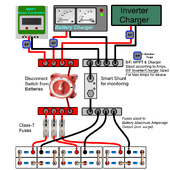
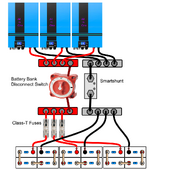
Hope it Helps & Good Luck + Happy Holidays !
Steve
Below are A-Typical" installations. Each battery pack is Fused. You can use MRBF (up to 36V) , Class-T or Mega-Fuses. for 12V, MRBF is very suitable. Each should be fused for Max Output amps which is likely 50A for each battery pack. You can have as many packs in parallel as you like. Just remember that both Load & Charge are divided proprotionately between the packs in the Battery Bank.
Assuming a typical battery pack. 50AH should be able to output a max of 50A for 1 hour and take 25A Charge for 2 hours MAX. 4 Packs combined can take 100A for 2 hours. ALTHOUGH it is better to charge at a slightly lower Amperage, usually around 0.3C, which translates to about 15A per battery pack.
YES, You can also have different sized battery pack in your bank. You can put a 50Ah, a 100AH and even a 200AH together BUT they will work proprotionately and you need access/control to the BMS' (Battery Management Systems) within the battery packs. There are pro's & con's along with a couple of pitfalls if there is too much diversity between packs. In such cases, it is best to NOT have more than 100AH differences which can be managed easily enough, beyond that, issues start to come up.
Keep your Charge Settings "Conservative" and do not push the batteries. Remember that all Lithium Chemistries are Millivolt & Milliohm sensitive, unlike Lead Acid batteries.
A Quick profile for charging that works. This is written for 24V, just correct for your voltage.
All equipment MUST BE Voltage Corrected & Calibrated (VERY IMPORTANT)
Divide Values X2 for 12V. Multiply X2 for 48V.
Absorb: 27.6 for 45 minutes (3.45vpc) (some call this boost) *I run a Bank of 5 packs, but never actually runs the full 45mins because of EndAmps
Equalize: OFF
Float 27.5V (3.437vpc)
MIn Volts: 21.2 (2.650vpc)
Max Volts: 28.6 (3.575vpc)
Rebulk Voltage: 25.6 (3.200vpc)
End Amps: 2.5A for your setup
- End Amps is calculated from the LOWEST AH Battery Pack in a Bank. IE: (50AH X 0.05 = 2.5A100AH X 0.05 = 5A)
NB: Victron Forum discussion says EndAmps = TailCurrent
Coulumbic Efficiency / Battery Status Meter Efficiency for LFP = 99%.
This gets the bank charged to full with high amps (Constant Current) and then float (Constant Voltage / variable current) tops off so the cells are at 3.47Vpc. I am running 7/24/365 so float is used up by the Inverter + provides whatever the packs will take to top off. (which is minimal)
* Do Not forget to adjust for Voltage Offsets between Actual Voltage @ Battery Terminal & at Solar Controller.
Very Special NOTE: Floating & Saturating to 3.437vpc, accounts for the Voltage Settling post Charge of any kind which actually brings the cells to just below 3.400Vpc.


Hope it Helps & Good Luck + Happy Holidays !
Steve
Yes, you should fuse each battery in parallel. Putting those 4 in parallel won't be an issue. You can even add a 100Ah one later on - you can mix capacities without issue with LiFePO4.
sorry. couldnt resist.
if youre not regularly fully charging your parallel system, you could eventually develop capacity and/or related issues. the method by which you make the connections will exacerbate the condition.
for (4) 50Ah in parallel i would use bus bars and fuse at the post of each battery to increase complexity and match the cost of simply going for (1) 200Ah battery.
if youre not regularly fully charging your parallel system, you could eventually develop capacity and/or related issues. the method by which you make the connections will exacerbate the condition.
for (4) 50Ah in parallel i would use bus bars and fuse at the post of each battery to increase complexity and match the cost of simply going for (1) 200Ah battery.
Good question. The answer in my opinion is it is better to have 4 in parallel. The reasons are two.... Is it better to have 1 200ah battery or 4 50ah batteries in parallel?...
1. The 50ah battery times 4 is often cheaper than the 200ah times 1.
2. In parallel if one battery does not produce you still will operate on the other 3.
Arguments can be made about complexity of wiring up 4 versus one and also space requirements.
thanks. so i need to fuse each of my batteries in parallel. i have a 150a mega fuse close to the battery.Yes, you should fuse each battery in parallel. Putting those 4 in parallel won't be an issue. You can even add a 100Ah one later on - you can mix capacities without issue with LiFePO4.
Steve_S
Offgrid Cabineer, N.E. Ontario, Canada
A VERY Important detail this... Parallel Packs offer Fallback & Failover protection if any pack drops the others can continue unless they are all at 0% SOC obviously.2. In parallel if one battery does not produce you still will operate on the other 3.
Each pack @ Busbar with an MRBF and then the Master Fuse (or breaker) in front of the Inverter/Charger/AIO.
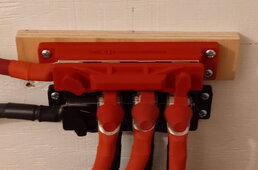 Here is part of my setup for 1.2 my bank.
Here is part of my setup for 1.2 my bank.Blue = Linked to Source.
Pike Industries 400A HD Busbars.
1 MRBF Fuse per pack.
A VERY Important detail this... Parallel Packs offer Fallback & Failover protection if any pack drops the others can continue unless they are all at 0% SOC obviously.
Each pack @ Busbar with an MRBF and then the Master Fuse (or breaker) in front of the Inverter/Charger/AIO.
View attachment 185028 Here is part of my setup for 1.2 my bank.
Blue = Linked to Source.
Pike Industries 400A HD Busbars.
1 MRBF Fuse per pacthis is my setup.I have not connected my batteries directly to a busbar. So I actually have to install a fuse at each plus terminal?
Attachments
Steve_S
Offgrid Cabineer, N.E. Ontario, Canada
1 fuse per battery...
We KNOW those bargain basement" bussbars - i've got 4 in the scrap pile... That plastic is not thermally safe and the bolts spin out if you are too vigorous... plus the 4mm thick tinned copper is dubious at best. I got 1 set, they were copper & plated, 2nd set came a few month later, tinned BRASS but all looks the same... They are like $35 for the pair on Amazon...
Watch this video for clarity.
We KNOW those bargain basement" bussbars - i've got 4 in the scrap pile... That plastic is not thermally safe and the bolts spin out if you are too vigorous... plus the 4mm thick tinned copper is dubious at best. I got 1 set, they were copper & plated, 2nd set came a few month later, tinned BRASS but all looks the same... They are like $35 for the pair on Amazon...
Watch this video for clarity.
I also have the cheap busbar from Amazon, but I rarely exceed 120A. So I understand that every battery must have a fuse. My main fuse is a mega 150A.what size should the fuse on the battery be?then I will look out for MRBF fuses1 fuse per battery...
We KNOW those bargain basement" bussbars - i've got 4 in the scrap pile... That plastic is not thermally safe and the bolts spin out if you are too vigorous... plus the 4mm thick tinned copper is dubious at best. I got 1 set, they were copper & plated, 2nd set came a few month later, tinned BRASS but all looks the same... They are like $35 for the pair on Amazon...
Watch this video for clarity.
If you run equal length cables from each battery to a bus bar, no problem. If you were to interconnect each battery (like shown in your picture) and then run a single pair of wires to a bus bar, you'll end up with batteries that aren't balanced.
For the technical details on why you DON'T want to connect the batteries like you have, see the following excellent thread.

 diysolarforum.com
diysolarforum.com
As Steve said, brass bus bars aren't ideal. I started out with a set of those not knowing what I had. 120 amps may be enough that you would heat up those brass bus bars. Test it out under load and see what happens. Also check your voltage drop.
For the technical details on why you DON'T want to connect the batteries like you have, see the following excellent thread.

Calculation of parallel string battery currents
Hi, everybody! I'm a retired EE. I didn't want my EE skills to fade away after retirment, so I exercise them when I can. Whenever I see a non-trivial circuit analysis problem on one of various forums I frequent, I challenge myself to solve it. Recently I watched Will's video about current...
As Steve said, brass bus bars aren't ideal. I started out with a set of those not knowing what I had. 120 amps may be enough that you would heat up those brass bus bars. Test it out under load and see what happens. Also check your voltage drop.
I read it. I didn't know that myself. I see a lot of DIY on YouTube that have the same connection as I see in the photo.So you don't have that problem with 1 large battery.to connect all 3 batteries to a busbar I would have to buy new cables of the same length...or make them the same length.If you run equal length cables from each battery to a bus bar, no problem. If you were to interconnect each battery (like shown in your picture) and then run a single pair of wires to a bus bar, you'll end up with batteries that aren't balanced.
For the technical details on why you DON'T want to connect the batteries like you have, see the following excellent thread.

Calculation of parallel string battery currents
Hi, everybody! I'm a retired EE. I didn't want my EE skills to fade away after retirment, so I exercise them when I can. Whenever I see a non-trivial circuit analysis problem on one of various forums I frequent, I challenge myself to solve it. Recently I watched Will's video about current...diysolarforum.com
As Steve said, brass bus bars aren't ideal. I started out with a set of those not knowing what I had. 120 amps may be enough that you would heat up those brass bus bars. Test it out under load and see what happens. Also check your voltage drop.
Considering that the pos and neg main cables are on the last and first of 3 batteries in parallel I fail to see how that it is wrong. His use of a busbar on the pos cable allows a handy place for his shunt voltage lead and what I assume is a fuse holder....
For the technical details on why you DON'T want to connect the batteries like you have, see the following excellent thread.
...
Considering that the pos and neg main cables are on the last and first of 3 batteries in parallel I fail to see how that it is wrong. His use of a busbar on the pos cable allows a handy place for his shunt voltage lead and what I assume is a fuse holder.
The batteries will eventually fall out of balance. The thread I provided a link to explains the situation with lots of examples.
I read it. I didn't know that myself. I see a lot of DIY on YouTube that have the same connection as I see in the photo.So you don't have that problem with 1 large battery.to connect all 3 batteries to a busbar I would have to buy new cables of the same length...or make them the same length.
Correct. One large battery is simple. Multiple batteries, more complex.
While I have only two (big) batteries, I still ran cables for each battery. Should I ever need to service one battery, the other battery continues working.
Steve_S
Offgrid Cabineer, N.E. Ontario, Canada
You said they are 50AH batteries, and if they are "standard" that means they can output 50A, therefore the fuse should be 50A. Many suggest a factor of 1.25, which would make the next up fuse would be 75A which is also fine because most can handle a short surge spike.I also have the cheap busbar from Amazon, but I rarely exceed 120A. So I understand that every battery must have a fuse. My main fuse is a mega 150A.what size should the fuse on the battery be?then I will look out for MRBF fuses
All of my DC cabling is Royal Excelene 4/0 Wire even though I am 24V. That's partly because my length from Inverter to Batt terminals is 4.2m/14'.
All of my cabling IS equal Length. Batt to Busbar & Busbar through to inverter.
I am going into the Finishing Phase finally, thank goodness, which will see 6x280AH Packs in Parallel and I am switching down the Pack to Busbar cables to 2/0 because these are reasonably short and 2/0 will handle it with elbow room.
Note on the cabling. Royal Excelene is High Grade Ultra-fine wire Welding cable, very $ but some of the best out there. With DC systems, especially higher currents, Fine Wire Cabling is the proper solution... Coarse wire (like in AC Wires) are not acceptable for this application.
REF to Southwire Royal Excelene:
Flexible Cord & Welding SPEC 70305
Sorry but I do not agree with that. It might become problematic when you have 4 or more in parallel. Even than the things that would cause a balance problem is more likely differing cell chemistries versus some minor voltage difference. There are times some folks overthink things.The batteries will eventually fall out of balance. The thread I provided a link to explains the situation with lots of examples.
...
There are times some folks overthink things.
You're just now noticing that?
Yes, we strive for perfection. I would be remiss if I didn't educate DIY'ers on how to make their system the best it can be.
I should check the manual to see what this 50ah battery peak current has.then I will have to place an MRBF Terminal Fuse Block of around 50a on each of the batteries so that if a short circuit occurs in one of the batteries, the fuse will blow.but it is not if I use for example 120a that the 50a MRBF blows?thx for the great tips folksYou said they are 50AH batteries, and if they are "standard" that means they can output 50A, therefore the fuse should be 50A. Many suggest a factor of 1.25, which would make the next up fuse would be 75A which is also fine because most can handle a short surge spike.
All of my DC cabling is Royal Excelene 4/0 Wire even though I am 24V. That's partly because my length from Inverter to Batt terminals is 4.2m/14'.
All of my cabling IS equal Length. Batt to Busbar & Busbar through to inverter.
I am going into the Finishing Phase finally, thank goodness, which will see 6x280AH Packs in Parallel and I am switching down the Pack to Busbar cables to 2/0 because these are reasonably short and 2/0 will handle it with elbow room.
Note on the cabling. Royal Excelene is High Grade Ultra-fine wire Welding cable, very $ but some of the best out there. With DC systems, especially higher currents, Fine Wire Cabling is the proper solution... Coarse wire (like in AC Wires) are not acceptable for this application.
REF to Southwire Royal Excelene:
Flexible Cord & Welding SPEC 70305
cabletechsupport.southwire.com
@davy
If you plan to go with 4x 12V 50Ah batteries in parallel, here's the link with the wiring diagram I've shared before.
Unless you need the bigger busbars, you could use one like in the picture to connect the two parallel sets in parallel and to the main cables.
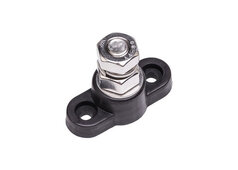
Hope it helps a bit.
If you plan to go with 4x 12V 50Ah batteries in parallel, here's the link with the wiring diagram I've shared before.
Unless you need the bigger busbars, you could use one like in the picture to connect the two parallel sets in parallel and to the main cables.

Hope it helps a bit.
Last edited:
thx.my setup is like in the diagram only not connected to a busbar@davy
If you plan to go with 4x 12V 50Ah batteries in parallel, here's the link with the wiring diagram I've shared before.
Unless you need the bigger busbars, you could use one like in the picture to connect the two parallel sets in parallel and to the main cables.
View attachment 185048
Hope it helps a bit.
Similar threads
- Replies
- 4
- Views
- 239
- Replies
- 9
- Views
- 462



